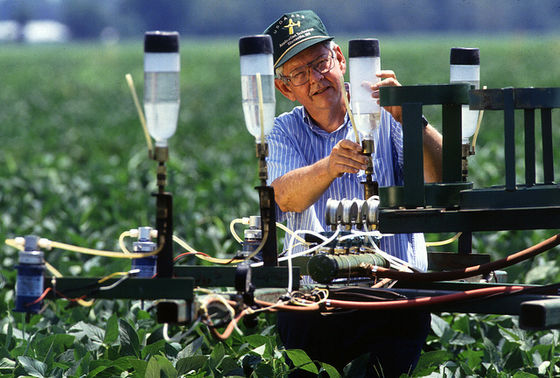Is genetically modified crop really dangerous?

ByStuart Caie
"Drinking nutrition functional food", which was commercialized to solve the global food shortage accompanying population increaseSorrentois. Genetically engineered crops are also used for that soil, but we reveal the "figure of the truth of genetically modified crops" that is understood because of such soils in the official blog.
Soylent Blog - Proudly Made with GMOs
http://blog.soylent.com/post/148000076992/proudly-made-with-gmos

It is said that one in nine people suffer from starvation on the earth, but despite this, the population of the earth continues to increase, and human beings are increasing by 2050 as the population growth rate rises We need to produce 70% more food than we need. By changing agricultural land to agricultural land and ranch to increase agricultural output, or increasing the production efficiency of existing farmland, it is possible to increase the amount of food production, but if it is a method using genetic manipulation It may be possible to optimize the demand for nutritional substances and to make foods with higher nutritional value available around the world.
Ethical controversy on genetic engineering has been done for a long time, but it is also a product of itGenetically modified crops(GMO) has been considered separately completely. As many critics talk about genetically engineered foods, we will talk about potential risks to human health, the environment, socioeconomic situation, etc. And, "Nature is complicated, the human body is like a black box, and the ecosystem is disorder itself", denying GMO etc. Introducing a variable called "GMO" in the existing system on Earth may certainly lead to losing various balance of the present situation.
On the contrary, breeding is expected to generate mutant species by natural mating. Since the 1920's, scientists have taken measures to expose seeds to chemical mutagenesis factors such as radiation for breed improvement, and to increase the amount of genetic variation by generation. By using such a technique called "induced mutation", we have continued to improve on some major crops, so now there are over 2,700 varieties rich varieties in food. Of course, the varieties produced by breed improvement "causing genes to change without using genetic recombination technology" are sold at the store with a label of "organic" affixed.
From these facts, Sorrent talks, "It is too irrational to deny genetic engineering technology from an ethical judgment," he says. Scientific consensus is obvious, and processes in genetic engineering are said to be "not dangerous" than genetic optimization such as breed improvement as above. And after this lengthy introduction, Sirerent claims the extent to which genetically engineered food has existed in the real world, its safety and sustainability etc.

BySnickclunk
Hundreds of safety tests have proved that GMO is not harmful to health. Indeed, well-known research institutes such as the American Academy of Sciences, the World Health Organization (WHO), the American Medical Association, the European Commission and the American Science Promotion Association all conclude that "there is no evidence that the GMO is not safe" I will. In addition, it has not been confirmed so far that GMO caused diseases, allergies and side effects of some kind by manipulating genes. In other words, GMO imposes safety standards different from ordinary crops, but there is no scientific basis for these.
For example I will consider papaya. Papaya is rich foods such as vitamins, minerals and dietary fiber, and if it can be mass-produced it can be a very good nutrition source for developing countries. There is a virus disease in this papaya which "prevents papaya from being produced all over the world". that isPRSVIt was a viral disease called "Hawaii" in the 1980s. However, in subsequent studies it has been shown that PRSV genes can be covered with shell protein and injected as a vaccine, preventing the onset of PRSV. Currently, this genetically engineered papaya accounts for about 70% of papaya produced in Hawaii, and this method seems to be the only way to grow papaya strong against viruses.
And genetically modified papaya resistant to PRSV is being produced all over the world. Furthermore, there is no evidence that the method of injecting shell protein affects the human body in terms of toxicology. Indeed, it has been demonstrated that proteins enter the gastric juice and decompose into amino acids in seconds.

ByCori Redford
Our current agricultural system, including deforestation, accounts for one-third of greenhouse gas emissions. The yield harvested by insects and weeds can be increased without increasing existing farmland and resources by enhancing insect resistance and herbicide tolerance by using genetic engineering. Furthermore, cultivating crops that are resistant to herbicides leads to reducing the labor involved in caring for the fields, so we humus the land or discharge greenhouse gasses by mechanical weeding methods It is no longer necessary.
According to Sirerent, "objectively the most benign of the existing herbicides is glyphosate based". This is aEPSPSIt stops the growth of plants by suppressing it. It was soybeans that genetic modifications tolerant to glyphosate for the first time were done, and in 1996 it was the first time that this tolerance food was marketed. And now it is said that 90% of the soybean cotton corn marketed in the United States is genetically modified with this glyphosate tolerance, which has a positive effect on crop productivity.
We have saved the labor of cultivating farmland with glyphosate tolerance and succeeded in reducing carbon dioxide emissions by 41 billion pounds (about 19 million tons) in the 17 years from 1996 to 2013. Criticism against crops that have glyphosate tolerance also exists, but considering the influence on the earth and human as a whole, it is obvious that better use of crops with glyphosate tolerance is better overall. And it is important that the amount of herbicide used is increasing due to the increase in the amount of crop with glyphosate tolerance, and the use of this herbicide in large quantities will harm the human body.

By
U. S. Department of Agriculture
The market for genetically modified foods has been born in the past 20 years, and its cultivation area has grown to over 170 million hectares, but it is more intensive research than obtaining scientific consensus or consumers It seems that work to investigate perception is delayed. There is a sufficient amount of data from a huge comparative experiment, but still there are underestimates of risks and underestimation of the benefits that may be brought about. In addition, the GMO seems to be used only with things that bring clear benefits and bring about a relatively negligible risk.
What is important for genetically modified foods is that they are more nutritious, sustainable and have higher harvesting efficiency, so there is a distinct advantage over those that are not genetically modified, such as orange, which is highly tolerant to carrots and bacteria of high calcium It is required to be. Most of the benefits of these genetically modified foods are for society, it is probably difficult for individual consumers to evaluate this, siirent.
In addition, Sorrent points out that the misunderstanding of the risk of genetically modified foods comes from the lack of awareness of the historical situation of human food systems in the past. Both crops and domestic animals are always located in genetic transformation, and agricultural production has taken in many technologies so far. And it is necessary to understand well that none of them are "zero risk".
Related Posts:
in Junk Food, Posted by logu_ii







